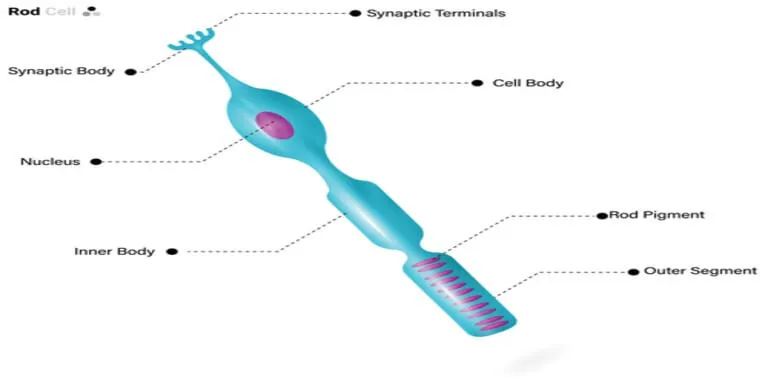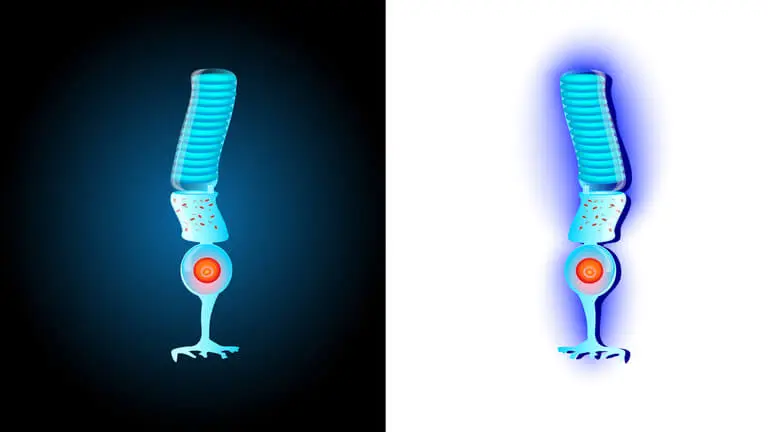The main difference between rods and cones is that rods are highly sensitive to light and can be used for low-light vision, whereas cones are suitable in highlight environments.
Rods and cones are the two categories of photoreceptors found in the retina.
The rods have a single type of light-sensitive pigment and are particularly sensitive to changes in light and dark, shape, and movement. However, cones only function in strong sunlight.
Table of Contents
What are Rods?

The retina of the eye contains rod and cone cells.
Seeing black and white images is a capability of rod cells.
They can detect shadows and variations in brightness and are more active in the dark than cone cells are.
Additionally, they are concentrated on the borders of the eyes rather than in the fovea, which is the focal center of vision.
One bipolar cell receives input from several rod cells (which feed to the optic nerve).
They provide a more basic form of eyesight because of their grayscale spectrum.
Rod cells are extremely sensitive to motion (as in bringing one’s attention to anything moving in the peripheral vision) and generate low-light, low-resolution vision.
At the intensities of daylight and even the majority of indoor artificial light, rod vision is basically nonfunctional. Additionally, monochromatic is rod vision.
Organelles In Rod Cells

Five main regions make up the rod cells
First outer segment:
- The connecting cilium
- Inner section
- The nucleus
- The synaptic area
The nuclear section houses the cell’s nucleus, whereas the inner segment is home to metabolic organelles such as the mitochondria, lysosomes, and endoplasmic reticulum.
Read more: What is the Difference Between Vaporization and Evaporation?
What are the Cones?

Colors can be seen by cone cells.
Red, green, and blue light can all be perceived by three different types of cones.
The center plane of vision is positioned near the retina of the eye, where they are mainly concentrated.
A single bipolar cell is represented by one cone. They provide a more refined and complicated kind of vision.
Cone cells, which require more intense light, generate high-resolution, trichromatic vision.
They are not, however, only visible in the daytime.
The moonlight reflected off of white paper and starlight has similar intensities as the threshold for activating cone vision.
Colors In Cone

Cone cells come in three different subtypes:
- Red-sensing cones make up 60% of them.
- Green-sensing cones at 30%.
- Blue-sensing cones at 10%.
What is the Difference Between Rods and Cones?
Rods are crucial for maintaining our retinal sensitivity, which makes them crucial in that sense.
On the other hand, cones play an important role in eye acuity.
Cones are used for specific, precise edge-detecting vision.
It is able to determine the shapes of some objects, whether it’s square or if it’s circular. Cones are also good for color vision.
The rod cells of the retina include a G-protein coupled receptor known as rhodopsin.
Rhodopsin was originally found in the form of the retina, which was securely coupled with a protein called opsin.
When exposed to light, opsin was broken down precisely where it had been bound.
Rods and cones are found on the retina’s inner lining near the rear of your eyes.
Cones are almost entirely found inside the macula lutea or the fovea. At the same time, rods are more common in the retina’s outer regions.
In the back of your eyes, there are photoreceptors called rods that take in light and transmit a neurological signal to the brain.
Rods are really more in a grayscale without color, and they specialize in your peripheral vision. We have about 120 million rods in our eyes.
Rods are also sensitive to motion, and they process our vision while we are in motion and while our surroundings are in motion.
Sensitive to motion means if something moves in your peripheral vision, it’s something that you are alerted to it.
Cones are another type of photoreceptor in our eyes that specialize in color and fine detail acuity.
We have about 6 million cones in each eye which is a lot less than those 120 rods, so we have way fewer cones in our eyes.
We have three different types of cones: red cones, blue cones, and green cones, so they’re great at identifying colors.
Your core vision contains those six million cones in its exact center.
When someone is gazing at the camera, they are likely using their cones to analyze their central vision, which accounts for around 5% of their vision.
Peripheral vision, which makes up roughly 95 percent of what we can see, is processed by 120 million rods in each eye, the majority of which are rods.
When light reflects off of the rods and cones, they absorb the information and send it as a signal down our optic nerve into our brain, where we are able to process and interpret what we see.
During the day, when there are a lot of colors, cones are slightly better at processing vision than rods, which predominate more at night, when we see primarily in darkness.
Cones are shorter and thicker than rods, which are long and thin.
Rods are not color sensitive and aid with night vision.
Rod cells in the retina, which are responsible for night vision, and cone cells, which are responsible for color perception, are both retinal cells of the eye.
This explains why women are better at color perception than males, despite having fewer cones in their retinas.
Because of this, color blindness affects more men than women.
They both support the perception of visible light inputs and their processing into electric signals that neurons in the optic nerve can transmit to the brain.
Difference Between Rods and Cones
Highlighting the difference between rods and cones in the following table:
| Rods | Cones |
| More photo pigment is found in rods. | Cones are less photo pigment |
| They are slow to respond | They are faster to respond. |
| They have a strong amplifying effect. | Their amplification is low. |
| They are more sensitive. | They are less sensitive. |
| Their acuity is low. | Their acuity is high |
| They only have one sort of pigment and are achromatic. | They have three types of pigments and are chromatic |
Conclusion
The main difference between rod and cone cells is that rod cells are highly sensitive and aid in seeing in low light, whereas cone cells need much lighter. The human eye has six million cones and roughly 120 million rods, with the three primary types of cones that sense blue, red, and green light.
Read more: What is the Difference Between Radius and Diameter?


